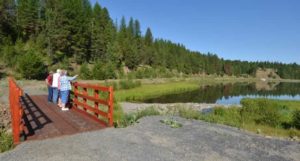 Although it was only mid-June, eastern Oregon was hot. We happened upon Bates State Park, near the headwaters of the Middle Fork of the John Day River, and discovered a lovely oasis with shade trees and green grass. At 4,000-feet elevation, the park offered cool relief at night.
Although it was only mid-June, eastern Oregon was hot. We happened upon Bates State Park, near the headwaters of the Middle Fork of the John Day River, and discovered a lovely oasis with shade trees and green grass. At 4,000-feet elevation, the park offered cool relief at night.
Bates State Park is the site of a former thriving lumber mill that operated for nearly 60 years. The 131-acre park is adjacent to the former Bates company town, home to about 400 families at its peak. In 1975, when a new mill was built in nearby John Day, the Bates mill was shut down and the town gradually disappeared. After the mill and many of the homes were dismantled, the land sat empty for more than 35 years.
A non-profit group, later named Friends of Bates State Park, worked tirelessly for many years advocating for the property’s preservation as a state park. Oregon Parks & Recreation Department purchased the land, and the park officially opened in 2011.
One of the central features of the park is the mill’s log pond. In its hey-day, local mill workers and ranch hands used to water ski in the pond, towed by a pick-up driving the bouncy road at the edge of the pond.
The park offers more than three miles of well-maintained hiking trails along the Middle Fork John Day River, Bridge Creek and Clear Creek. Interpretive panels throughout the park describe Bates life in the early to mid-20th Century and the steps taking place now to restore the land and waterways.
Although the park’s 28 sites do not offer hookups, there’s plenty of space to park rigs or to set up tents.
The area is a rich fish habitat. The Middle Fork of the John Day River and its tributaries are home to Chinook salmon, steelhead, trout and other native fish. Oregon Parks & Recreation are currently in the early stages of a restoration project, including a fish ladder, that would improve access to 14 miles of ideal fish habitat.
We found that Bates State Park makes a great home base when touring the area. The campground is situated between three nearby Wilderness Areas: Strawberry Mountain and Monument Rock to the south and North Fork John Day to the north. Hikers can climb to spectacular views atop Indian Rock and Vinegar Hill, which together make up the summit of the Greenhorn Range of the Blue Mountains.
Bates is convenient to the Old West Scenic Bikeway, a 174-mile loop that passes through landmarks such as John Day Fossil Beds National Monument. The park is also on route for cross-country cyclists touring the TransAmerica Trail, which runs along nearby Oregon Highway 7.
On U.S. Highway 26, nine miles from Bates State Park, we found a nice little hike at the old Sumpter Valley Interpretive Trail that overlooks the historic Dixie Switchbacks. The tracks were used by the Sumpter Valley Railway that connected Prairie City, Oregon to Baker City, Oregon.
Bates State Park was a great find–just our kind of place.


This park goes on my list for next June. I love Eastern Oregon!!
It is a fun place, Irene. You won’t have that far to go!